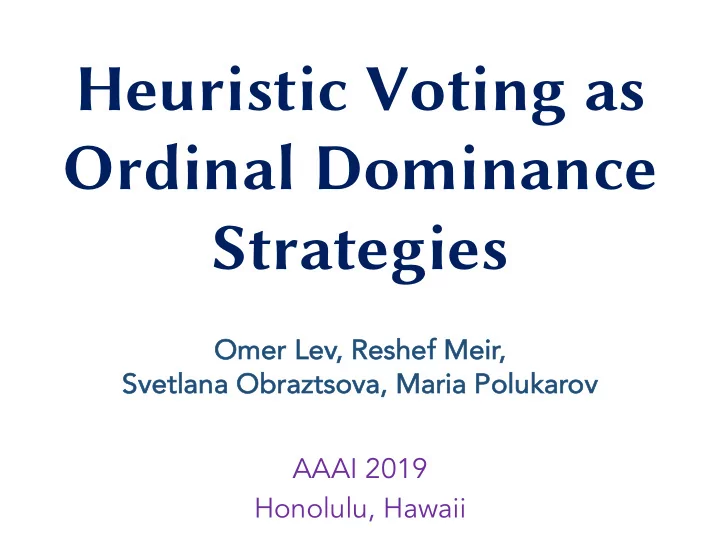

Heuristic Voting as Ordinal Dominance Strategies Omer Le Lev, Reshef Meir, Sve vetlana Obraztsova ova, Maria Poluka karov AAAI 2019 Honolulu, Hawaii
Voting A set of voters – V A set of options (candidates) – C A voting function f to take in voters preferences, and output an outcome
Voting manipulation Gibbard–Satterthwaite Other than in a dictatorship, when agents kn know how ot others ar are v e vot oting , they may be better off voting differently than they believe.
Voting manipulation Uncertainty? What do you do when you do not know what all others are voting for?
Voting manipulation Uncertainty? What do you do when you Not Not pr probabi obabili lity! do not know what all others are voting for?
Heuristics Not probability! A function that takes a certain state and outputs what should the voter vote for: An arbitrary candidate that isn’t the least favorite. Truth bias Lazy bias T-pragmatist Leader rule
Previously… Local dominance A binary model – probable/improbable states, calculated by a metric from a base data point (e.g., poll). Among the probably states, choose a dominant strategy. Meir, L., Rosenschein A Lo Local-Do Domi minan ance Th Theory ry of Voting Equilibri ria , EC 2014
A small(?) change Multiple in ts , denoting which informa rmatio ion sets is more probable than another
A small(?) change Multiple in informa rmatio ion sets ts , denoting which is more probable than another. Each has an equivalent pi pivot t gra graph ph . A B
A small(?) change Multiple in informa rmatio ion sets ts , denoting which is more probable than another. Each has an equivalent pi pivot t gra graph ph . A B A B C
A small(?) change Multiple in informa rmatio ion sets ts , denoting which is more probable than another. Each has an equivalent pi pivot t gra graph ph . A B A B C A B C
A small(?) change Multiple in informa rmatio ion sets ts , denoting which is more probable than another. Each has an equivalent pi pivot t gra graph ph . A B A B C A B Each level is nested in the subsequent ones C
Ordinal domination Action a dominates action b if there is A B an information set where a dominates A B b . C A B C
Different graphs for different heuristics Arbitrarily voting for anyone that isn’t least favorite: A graph where all candidates are tied with each other.
Different graphs for different heuristics Local dominance: A graph where candidates of a certain distance from the winner are tied.
Different graphs for different heuristics Truth-bias / Lazy-bias: Level 1: as in local dominace. Level 2: Truthful vote connected to all nodes in level 1.
Different graphs for different heuristics Leader rule Level 1: top two candidates Level 2: ”star” connecting winner to all other candidates.
Iterative voting & local dominance Regular metric distances induce pivot graphs that are upward closed (if tied with a candidate, also tied with candidates with higher scores). When using candidate-wise rules, such as ℓ ∞ , the pivot graph is a clique at every level
Iterative voting & local dominance If voters’ model is a cliqued one, the will converge using ordinal dominance when using plurality or veto.
Iterative voting & local dominance If voters’ model is a cliqued one, the will converge using ordinal dominance when using plurality or ve veto . Ne New Known from previous result, Meir, Pl Plurali lity y vo voting under unce certainty , AAAI 2015
Future directions More matchings between heur heurist stics s and nd graphs hs Creation of no novel el heur heurist stics s using graphs Co Convergence results using graph topology Gr Graph ph to topology meaning? More unc uncer ertaint nty rep epresent esentations ns using graphs
Thanks for listening!
Recommend
More recommend